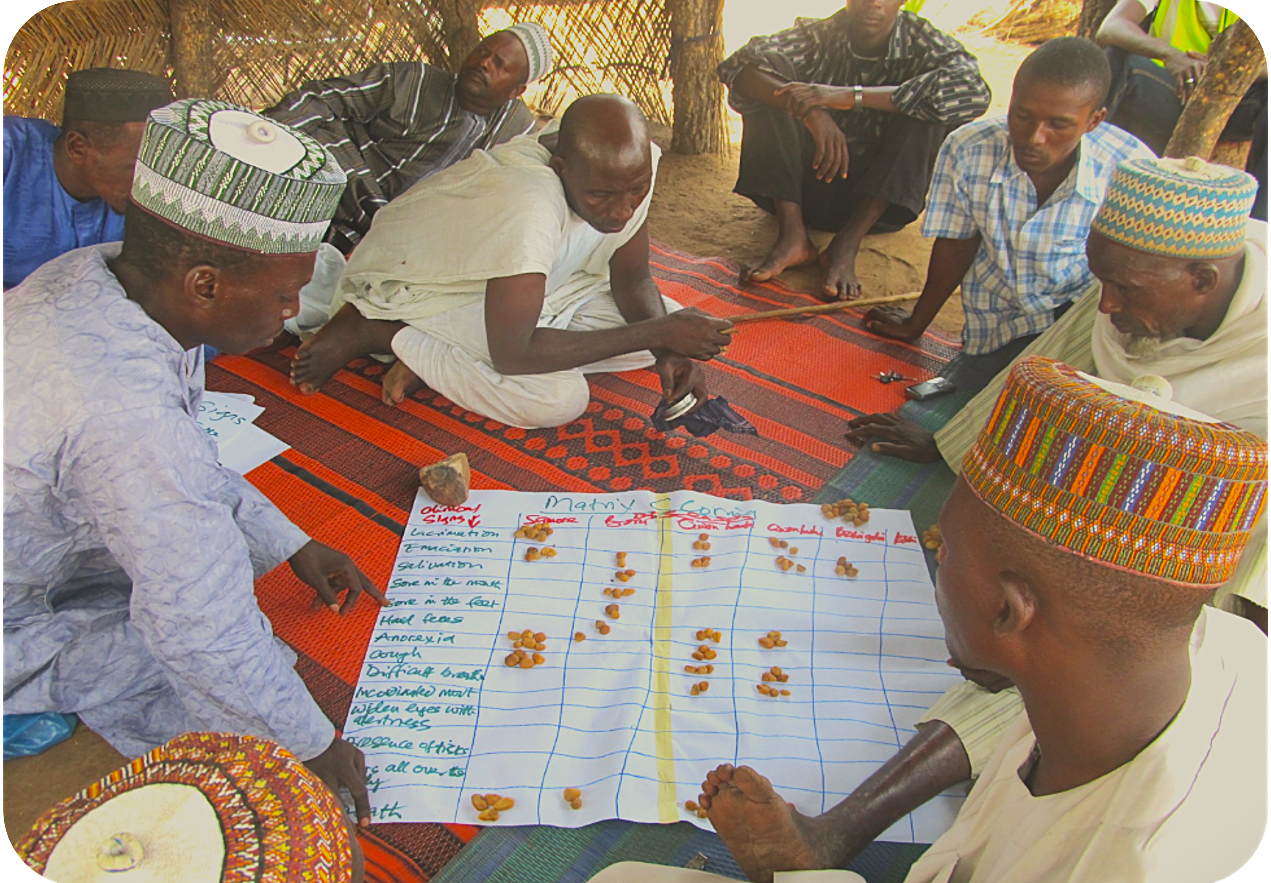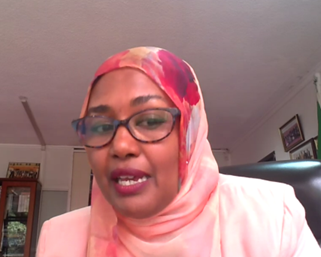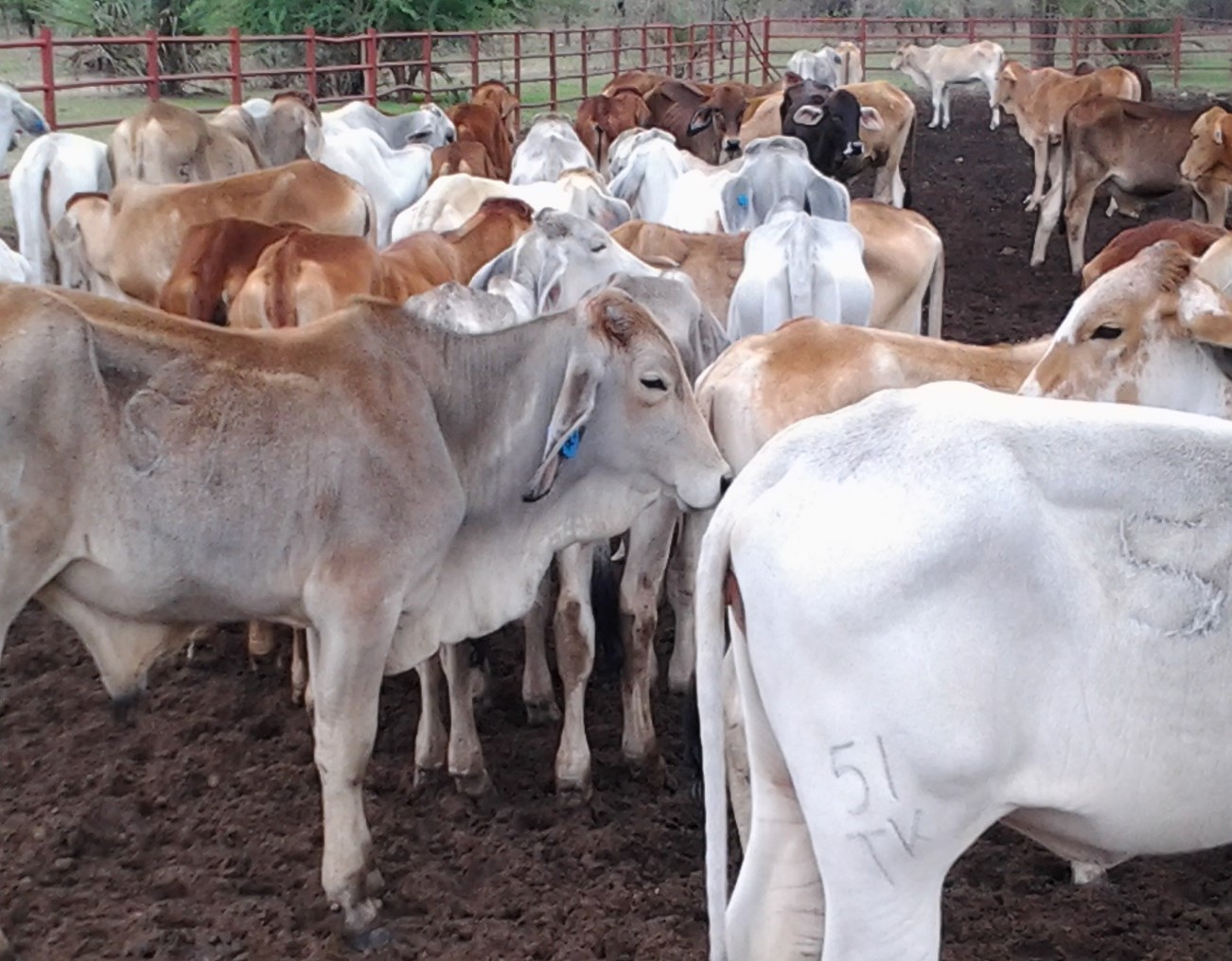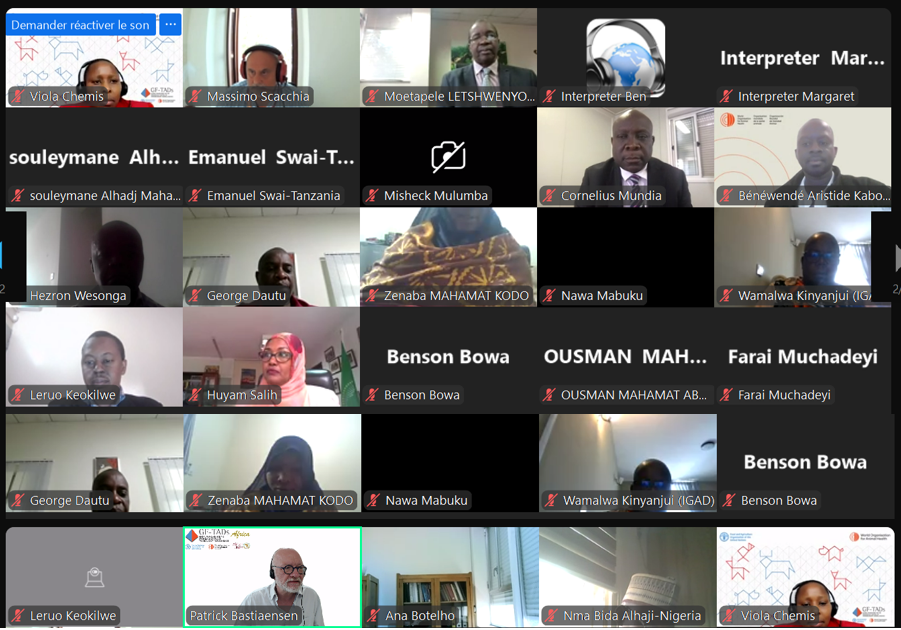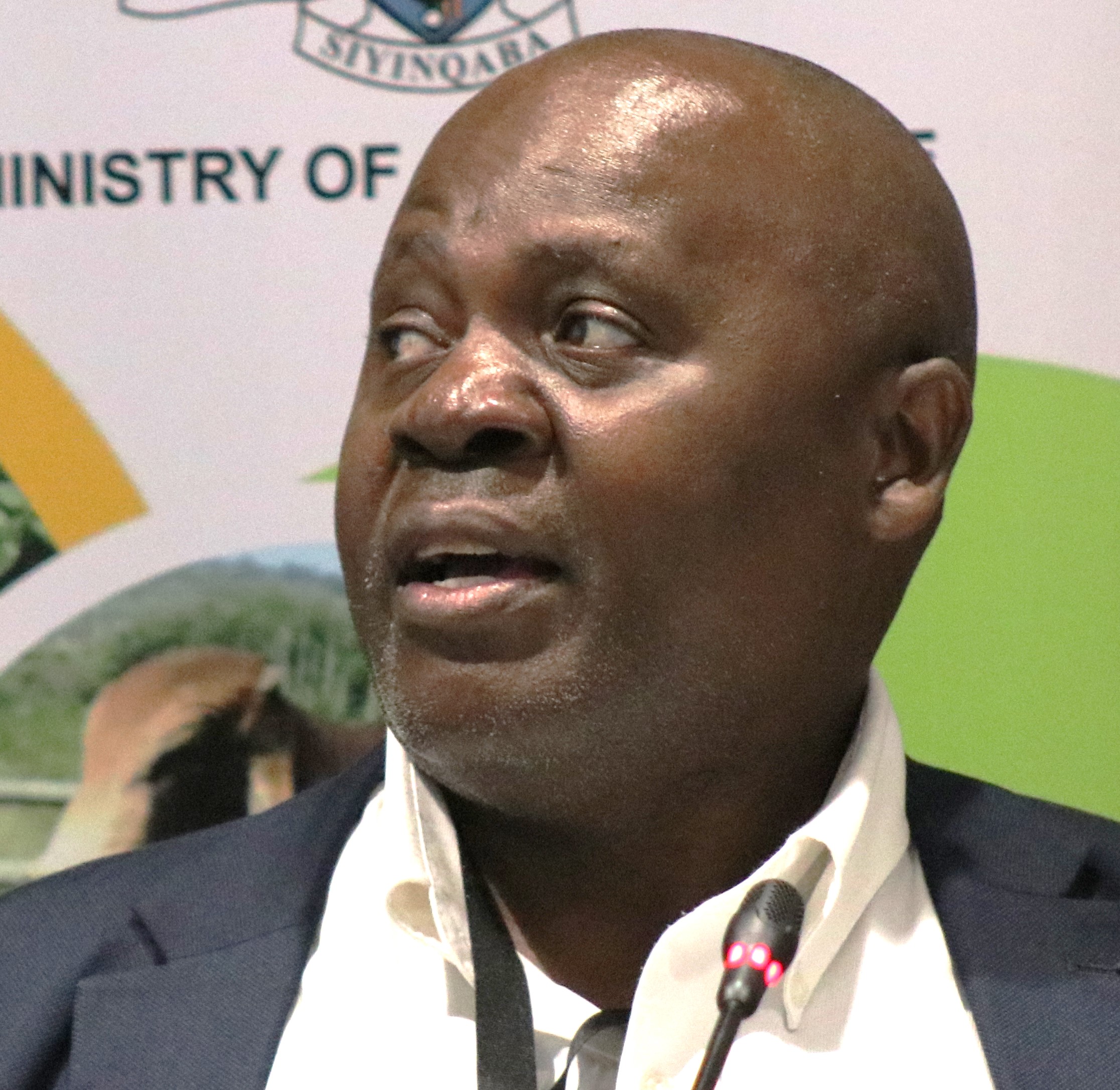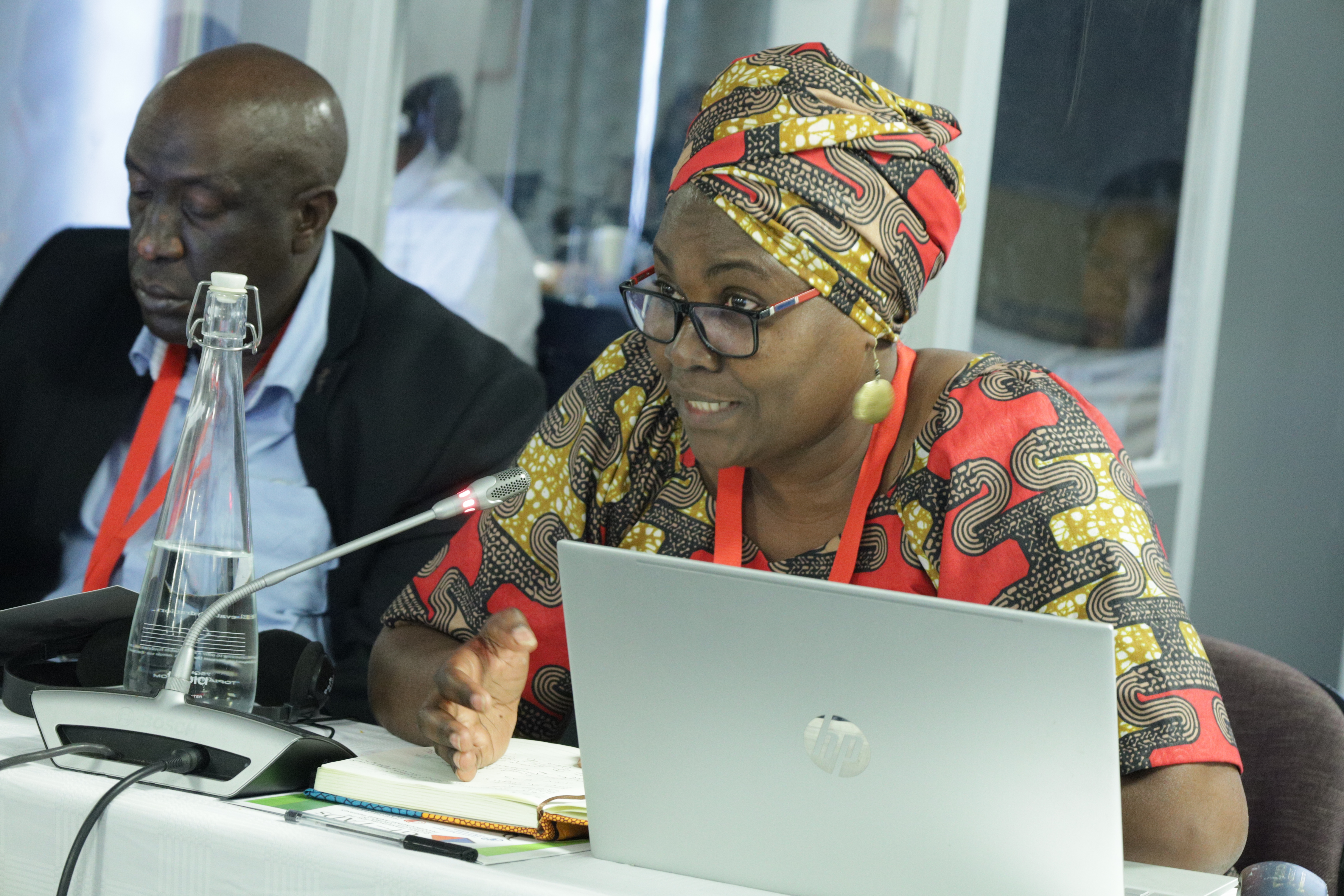
Participatory Epidemiology - CBPP - Picture (c) Nma Bida El-Hadj (University of Ibadan) 2013
Epidemiologie participative – PPCB – Photo (c) Nma Bida El-Hadj (Université de Ibadan) 2013.
La réunion (virtuelle) du troisième Groupe Permanent d’Experts (GPE) pour la péripneumonie contagieuse bovine (PPCB) s’est tenue en trois sessions, entre le 5 et le 7 mai 2025, avec la participation de trois Directeurs des Services Vétérinaires (DSV) / Délégués de l’OMSA, de l’Eswatini (en tant que Vice-président du GF-TADs pour l’Afrique RSC), de la Zambie (en tant qu’Expert régional PPCB) et du Nigéria (nouvellement désigné). Dans l’ensemble, 43 personnes ont participé à la réunion en ligne au cours des trois sessions, avec un maximum de 36 participants par jour. Vingt-huit pour cent (28%) des participants inscrits étaient francophones et 32% des participants étaient des femmes.
Étaient également représentés à la réunion (en tant que Membres statutaires ou Observateurs) :
Communautés économiques régionales (CERs)
Laboratoires nationaux au service de la région
Laboratoires de Référence
Le Groupe permanent d’experts pour la péripneumonie contagieuse bovine (GPE-PPCB) pour l’Afrique a été créé à la suite de l’adoption en juin 2022 des termes de référence par le 11e Comité de Pilotage Régional (CPR11) du GF-TADs pour l’Afrique, afin de promouvoir l’échange régulier d’informations et de meilleures pratiques entre les autorités vétérinaires nationales concernées, les experts internationaux et nationaux, et le secteur privé.
En 2021, la PPCB avait été identifiée comme l’une des 5 maladies prioritaires dans le cadre de la Stratégie régionale 2021 – 2025 du GF-TADs, adoptée en octobre 2021. Cela a conduit à la création du GPE PPCB pour l’Afrique en 2023, qui a commencé avec un noyau de 4 pays membres fondateurs issus de l’Afrique centrale (Tchad), orientale (Somalie), australe (Zambie) et occidentale (Nigeria), avec l’objectif de s’étendre progressivement à d’autres pays. Le GPE inaugural avait identifié un certain nombre de sujets prioritaires, qui seront abordés lors des réunions suivantes, comme le prévoient les termes de référence du GPE
Ces sujets sont :
Après une deuxième réunion réussie du Groupe permanent d’experts (GPE) pour la PPCB, qui s’est tenue à Lusaka, en Zambie, en juillet 2024, ce troisième GPE a été planifié pour discuter de la surveillance, définie comme suit :
| Une surveillance renforcée permettant de récolter plus d’informations sur la maladie et d’assurer une notification plus fiable et de meilleure qualité.
|
|
President of the Regional Steering Committe of the GF-TADs for Africa and Director of AU-IBAR, Dr Huyam Salih.
Distinguished Delegates, esteemed colleagues, partners, and experts, it is my distinct honor to welcome you all to the third meeting of the Standing Group of Experts (SGE) on Contagious Bovine Pleuro-Pneumonia (CBPP), organized under the auspices of GF-TADs for Africa. As President of the GF-TADs Regional Steering Committee for Africa, I am grateful for your presence and your unwavering commitment to advancing livestock health in our continent.
At AU-IBAR, our dedication to tackling TADs is resolute. We remain committed to developing and implementing continent-wide strategies for the prioritized TADs identified by GF-TADs Africa. Among these, CBPP is a significant challenge that impacts the livelihoods of countless farmers and pastoralists. We are therefore actively planning a comprehensive CBPP Strategy, expected to be finalized in 2026, which will serve as a roadmap for coordinated, effective prevention and control actions across Africa.
In support of this effort, we have resumed an important collaboration with Texas A&M University update the regional Standard Methods and Procedures (SMP) for ten key TADs, including CBPP and produce the continental once. The work has been already initiated on the first week of April, and the next workshop is planned for July 2025. These protocols will establish standardized benchmarks for disease surveillance, monitoring and control measures across the continent, fostering harmonized efforts and facilitating data sharing. Our goal is to develop these SMPs into continental guiding documents that ensure regional and inter-regional standards, strengthening our collective capacity for early detection and informing quarantine and trade decisions.
However, I must acknowledge that our surveillance and reporting systems face considerable challenges. Weak systems, inconsistent reporting, and limited funding hamper our ability to respond swiftly and effectively to outbreaks. To address these obstacles, we need innovative solutions: mobilizing resources through public-private partnerships, establishing regional coordination platforms, and integrating risk-based surveillance approaches that prioritize high-risk zones. These strategies will enable us to allocate limited resources more efficiently, improve data accuracy, and support targeted interventions.
Risk-based surveillance is particularly vital. It enhances our ability to support control programs, guide quarantine measures, and inform safe trade practices—crucial for safeguarding animal health and maintaining market access.
Today’s discussions are critical. Your insights and expertise will help refine our strategies and operationalize effective surveillance systems that are sustainable and collaborative. Only through strengthened regional and inter-regional coordination can we overcome these challenges and move towards a stronger, resilient livestock sector in Africa.
In closing, I reaffirm AU-IBAR’s commitment to supporting member states in building resilient, data-driven surveillance and control systems. Together, through collaboration, innovation, and unwavering dedication, we CAN strengthen our defenses against CBPP and other TADs, securing the health of our animals, the livelihoods of our farmers, and the prosperity of Africa.
Thank you for your active participation, and I look forward to fruitful discussions and collective action.
_______________________
Madam Chair, Dr. Huyam Salih,
Vice Chair, Dr. Roland Dlamini,
Distinguished experts, partners, and colleagues, good morning.
On behalf of Dr. Abebe Haile-Gabriel, the FAO Assistant Director General and Regional Representative for Africa, it is my great pleasure to welcome you to the third Meeting of the Standing Group of Experts on Contagious Bovine Pleuro-Pneumonia (CBPP) under the Global Framework for the Progressive Control of Transboundary Animal Diseases (GF-TADs) for Africa. As the FAO regional focal person for the animal production, health and One Health and Vice Chair of the GF-TADs Africa, I am honored to be part of this crucial gathering.
Surveillance is critically important for controlling any transboundary animal disease, as it requires data-driven decisions. Surveillance coupled with early and rapid diagnosis are critically important to quick responds to TADs. Contagious Bovine Pleuropneumonia is a significant threat to livestock health, productivity and trade in Africa. A GALVmed report shows that the disease affects 27 countries in Africa and incurs an estimated annual cost of USD 2 billion. Effective control of CBPP is essential for sustainable livestock transformation and trade, as it directly impacts food security, nutrition and economic stability in the region.
The FAO has been at the forefront of efforts to prevent and control CBPP, emphasizing the importance of building robust animal health systems. Through technical assistance, capacity building, and the development of surveillance tools and strategies, FAO supports countries in enhancing their ability to detect, monitor, and respond to CBPP and other transboundary animal diseases. This approach ensures that countries are equipped with the necessary tools, knowledge and capacities to manage the disease effectively. It is crucial to emphasize that the surveillance of contagious bovine pleuropneumonia requires countries to invest significantly in their animal health systems. National governments must prioritize the development and strengthening of these systems to ensure effective disease prevention and control. This investment is essential for building the capacity needed for surveillance, early detection, and quick response to CBPP and other transboundary animal diseases.
A skilled workforce is critically important for the detection of CBPP in clinical and postmortem examinations, including abattoir inspections. Building early and accurate diagnostic capacities in the countries, including regional laboratory support, is of paramount importance. FAO’s virtual learning centre (VLC) and professional training on epidemiology have proved to be effective tools that help train veterinarians and paraprofessionals at scale. Capacity enhancement and adaptation to digital tools, artificial intelligence and other emerging technologies and innovations should be leveraged to quicken surveillance and data precision. CBPP can be controlled by vaccinations, meaning proper surveillance and vaccination can help countries to free themselves from CBPP, if not the whole country, certainly through compartmentalization. Countries need to strategise and implement vaccinations. Intergovernmental organizations, including FAO, WOAH, AU-IBAR, AU-PANVAC, Africa regional economic communities and partners play a vital role in supporting countries’ efforts to control CBPP. Their focus is on providing technical assistance and acting as catalysts for change, rather than performing tasks that should be managed by the countries themselves. These organizations offer expertise, resources, and strategic action plans to guide national efforts, fostering collaboration and sharing knowledge across borders.
Ladies and gentlemen, let us continue our active engagement, share our knowledge, and work towards sustainable solutions that will benefit our members, communities, and economies. The discussions and deliberations over the next few days are not just academic exercises; they are vital steps towards tangible improvements in CBPP surveillance and control. I encourage each of you to contribute your insights, ask questions, and propose innovative solutions. Your participation is crucial in shaping the future of CBPP management in Africa. I look forward to fruitful deliberations and impactful outcomes from this meeting. As we embark on this journey together, let us remain focused on our goals and committed to making a difference. The challenges we face are significant, but with our collective expertise and determination, we can overcome them and achieve lasting progress. Thank you.
____________________
Grâce à une série de présentations techniques mais aussi politiques, de sondages MentiMeter(TM) et de débats, la réunion a été conduite à travers les différentes sessions, en commençant comme d’habitude par les aspects de gouvernance (nouveau Membre, Tunisie) et le récapitulatif de la session précédente, c-à-d. la deuxième réunion du Groupe permanent d’experts (GPE) pour la PPCB, qui s’est tenue à Lusaka, en Zambie.
Cattle branding at Siandenge Farm, Namwala district of Southern Province in Zambia. Picture (c) DVS (Zambia) 2024
Les agences techniques, les laboratoires de référence, les CER et les pays (Membres) ont été invités à partager leurs points de vue sur les approches de surveillance susmentionnées, leurs succès et leurs défis. Des experts invités du Nigeria (Dr. Bida), de la Tanzanie (Dr. Swai) et de la Zambie (Dr. Mulumba) ont apporté un éclairage supplémentaire sur les approches d’épidémiologie participative, la surveillance au niveau des abattoirs et les normes générales de surveillance de l’OMSA, respectivement.
Les présentations faites lors de la réunion peuvent être téléchargées ci-dessous.
Marquage du bétail à la ferme Siandenge, dans le Département de Namwala, dans la Province du Sud, Zambie. Photo (c) DSV (Zambie) 2024
En fin de compte, après trois jours de consultations, la réunion a résolu et convenu (provisoirement, en attente de validation) de ce qui suit :
Dans les semaines à venir, les considérations et les points d’action seront affinés et un rapport sera préparé et diffusé.
La prochaine réunion du GPE sera consacrée au diagnostic, c’est-à-dire au renforcement des réseaux entre les laboratoires de référence nationaux, les laboratoires de référence nationaux offrant des services régionaux et les laboratoires de référence internationaux, et, à terme, à l’augmentation du nombre de laboratoires de référence OMSA/FAO en Afrique.
PDF - 1.09MB
PDF - 1.65MB
